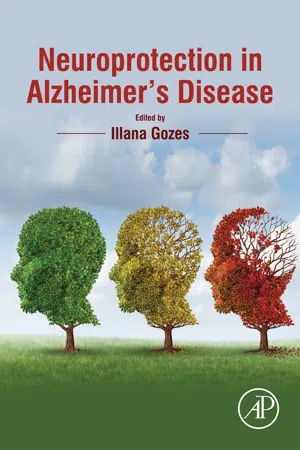
- 342 pages
- English
- ePUB (mobile friendly)
- Available on iOS & Android
Neuroprotection in Alzheimer's Disease
About This Book
Neuroprotection in Alzheimer's Disease offers a translational point-of-view from both basic and clinical standpoints, putting it on the cusp for further clinical development with its emphasis on nerve cell protection, including the accumulation of knowledge from failed clinical trials and new advances in disease management.
This book brings together the latest findings, both basic, and clinical, under the same cover, making it easy for the reader to obtain a complete overview of the state-of-the-field and beyond. Alzheimer's disease is the most common form of dementia, accounting for 60 to 80 percent of dementia cases. It is a progressive brain disease that slowly destroys memory, thinking skills, and eventually, even the ability to carry out the simplest tasks. It is characterized by death of synapses coupled to death nerve cells and brain degeneration which is manifested by loss of cognitive abilities. Understanding neuroprotection in Alzheimer's disease will pave the path to better disease management and novel therapeutics.
- Comprehensive reference detailing neuroprotection in Alzheimer's Disease, with details on nerve cell protection and new advances in disease management
- Combines the knowledge and points-of-view of both medical doctors and basic scientists, putting the subject at the forefront for further clinical development
- Edited by one of the leading researchers in Alzheimer's Disease
Frequently asked questions
Information
Introduction
Keywords
Neural Regeneration as a Disease-Modifying Therapeutic Strategy for Alzheimer’s Disease
* Department of Neurochemistry, & SUNY Downstate/NYSIBR Center for Developmental Neuroscience, New York State Institute for Basic Research (NYSIBR), Staten Island, NY, United States
** Neural and Behavioral Science Program, School of Graduate Studies, State University of New York (SUNY) Downstate Medical Center, Brooklyn, NY, United States
Abstract
Table of contents
- Cover
- Title page
- Table of Contents
- Copyright
- Dedication
- List of Contributors
- Acknowledgments
- Chapter 1: Introduction
- Chapter 2: Neural Regeneration as a Disease-Modifying Therapeutic Strategy for Alzheimer’s Disease
- Chapter 3: Animal Models of Alzheimer’s Disease
- Chapter 4: Mechanisms of Neuronal Microtubule Loss in Alzheimer’s Disease
- Chapter 5: Tau-Centric Therapies for Treating Alzheimer’s Disease
- Chapter 6: The Potential of Small Molecules in Preventing Tau Oligomer Formation and Toxicity
- Chapter 7: A Novel Neuroprotection Target With Distinct Regulation in Stroke and Alzheimer’s Disease
- Chapter 8: Sirtuin Modulation as Novel Neuroprotective Strategy for Alzheimer’s Disease
- Chapter 9: Rescue of Neurons by Resolving Inflammation
- Chapter 10: Targeting Transition Metals for Neuroprotection in Alzheimer’s Disease
- Chapter 11: Multifunctional Effects of Human Serum Albumin Toward Neuroprotection in Alzheimer Disease
- Chapter 12: RGS2 and SIRT1 Link Renin Angiotensin Aldosterone System to Alzheimer’s Disease
- Chapter 13: Neuroprotective Drug Development: The Story of ADNP, NAP (Davunetide), and SKIP
- Author Index
- Subject Index